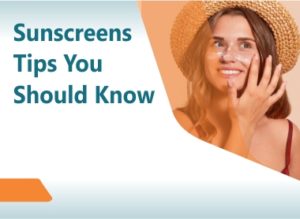

THE BENEFITS OF USING SUNSCREEN
Why should you use sunscreen? The primary use of sunscreens is to protect the skin from the short-term and long-term effects of ultraviolet radiation. In today’s scenario of procedure-centered dermatology, sunscreens have become an indispensable part of every patient’s post-procedure skincare routine. The common indications for the use of sunscreens in dermatology care in the prevention and management of:
- Sunburn
- Freckling, discoloration
- Photoaging
- Skin cancer
- Phototoxic/ photoallergic reactions
- Photosensitivity diseases
- Polymorphous light eruption (290-365 nm)
- Solar urticaria (290-515 nm)
- Chronic actinic dermatitis (290 nm-visible)
- Persistent light reaction (290-400 nm)
- Lupus erythematosus (290-330 nm)
- Xeroderma pigmentosum (290-340 nm)
- Albinism
- Photoaggravated dermatoses
- Post-inflammatory hyperpigmentation (post-procedure)
One of the most obvious worth mentioning benefits of Sunscreen is that it prevents the early onset of fine lines and wrinkles. Isn’t this factor is actually notable? So, yes, if you use sunscreen, you won’t have to experience premature aging signs and will have flawless skin in the future. The skin is the largest organ of the body and guards the body; however, not paying proper attention to the skin should not be done – Your skin requires protection, care, and a shield. Without sunscreen, the skin is vulnerable to a host of issues. Do you know how much the UV rays harm the skin? The Spectrum of UV radiation The biologically active components of ultraviolet (UV) radiation include UVA and UVB radiation. The primary targets of UV radiation in the skin are: UVB (290-320 nm)
- Responsible for the most severe damage
- Direct impact on cell DNA and proteins
- Acute damage – sunburn
- Long-term damage – cancer
UVA (320-400 nm)
- Not directly absorbed by biological targets
- Penetrates deeper than UVB
- Affects connective tissue by producing reactive oxygen species; produces profound immunosuppression
- Responsible for tanning, photoaging, photocarcinogenesis, exogenous photosensitization and many idiopathic photodermatoses (including polymorphous light eruption)
Hence by just adding one thing to your daily routine, i.e., applying sunscreen, you are wiping out all the problems (mentioned above).
Classification of Sunscreens:
(A) Organic sunscreen Organic sunscreens are further divided into UVB and UVA filters: 1. UVB filters
- PABA derivatives – Padimate O
- Cinnamates – Octinoxate, Cinoxate
- Salicylates – Octisalate, Homosalate, Trolamine salicylate
- Octocrylene
- Ensulizole
2. UVA filters
- Benzophenones (UVB and UVA2 absorbers) – Oxybenzone, Sulisobenzone, Dioxybenzone
- Avobenzone or Parsol 1789 (UVA1 absorber)
- Meradimate (UVA2 absorber)
(A) Inorganic sunscreen
- Titanium dioxide
- Others – iron oxide, red veterinary petrolatum, kaolin, calamine, ichthammol, talc
- Inorganic agents function by reflecting, scattering, or absorbing UV radiation. Their opaque nature and “whitening effect” are inherent disadvantages, which may be minimized by the use of micronized or ultrafine particles.
Recommendations for Sunscreen Application
Introducing the best sunscreen that provides complete protection and acts as a safeguard for the skin throughout the day. Sunprotek Gel is a broad spectrum UVA/UVB defending sunscreen, an ideal choice for acne-prone skin. It is the first of its kind gel-based sunscreen that is formulated with unique water-oil-water emulsion nanotechnology. Sunprotek should be appropriately applied to all sun-exposed areas (in a concentration of 2 mg/cm 2) and allowed to dry completely before sun exposure. It should be reapplied every 2 hours and after swimming, vigorous activity, excessive perspiration, or toweling. “Teaspoon rule”: 3 mL (slightly more than half a teaspoon)
- for each arm
- for the face and neck
- 6 mL (slightly more than a teaspoon)
- for each leg
- for the chest
- for the back
Debatable Issues Sunscreen use in infants Although not known to be hazardous, the use of sunscreens is not recommended for infants younger than 6 months. The most common cause of contact dermatitis (photoallergy) among sunscreens is oxybenzone. Nanosized particles Nanosized particles range in size from 1-100 nm. Microfine forms of zinc oxide and titanium dioxide have a particle size of 20-50 nm. Nanotechnology makes inorganic sunscreens more cosmetically acceptable (less whitening of skin after application). In recent years, there have been concerns that nanoparticles can induce free radical formation in the presence of UV radiation. However, studies show that these particles remain on the skin’s surface or in the stratum corneum and are safe for human use. Vitamin D production UVB radiation is responsible for more than 90% of vitamin D production in the skin. It is said that a few minutes of exposure of the face, arms, and hands to noonday summer sunlight two or three times a week is sufficient for vitamin D synthesis. [14] There have been concerns that widespread use of sunscreens, particularly those with high SPF, may significantly decrease vitamin D production. However, there is evidence that though sunscreens can significantly reduce the production of vitamin D under very strictly controlled conditions, their normal usage does not generally result in vitamin D insufficiency. Vitamin D and calcium levels have been found to be relatively normal in xeroderma pigmentosum patients despite strict photoprotection. New Sunscreen Technologies: Microencapsulation Active sunscreen ingredients are entrapped within a silica shell, as a result of which allergic or irritant reactions to the active ingredient can be minimized, and incompatible sunscreen ingredients can be safely combined without the loss of efficacy.
Take-Home Message
Do you know the skin takes up half-hour absorbing the sunscreen properly? So apply sunscreen 30 minutes before going outside, and have fearless days going directly in front of the sun. Sunprotek is the first time in India gel-based sunscreen with unique water-oil-water encapsulation nanotechnology for better spreadability and uniformity.
- Be sure you apply enough sunscreen leaving from the home
- Use Sunprotek on the parts of the skin exposed directly to the sun
- Apply thoroughly
Our Sunprotek is easy to apply, perfect for daily use, and protects the skin from sun damage every day!
